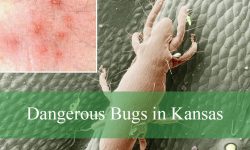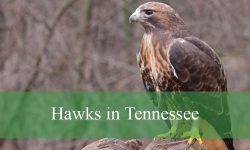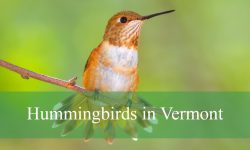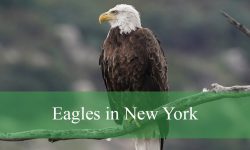Florida’s rich wildlife includes two native skunk species that often go unnoticed until their signature scent fills the air. These shy nocturnal mammals are more than just a smelly nuisance—they play a valuable role in the ecosystem by controlling insects and small rodents.
The state is home to the Eastern Spotted Skunk and the Striped Skunk, both of which are members of the weasel family. Each species has distinctive markings, behaviors, and habitat preferences that make them fascinating and important to Florida’s natural balance.
This guide offers in-depth details on how to identify these skunks, where they live in Florida, how they behave, and what makes each species unique. Learning about them can help foster better understanding and coexistence with native wildlife.
Common Skunks Found in Florida
Eastern Spotted Skunk (Spilogale putorius)

The Eastern Spotted Skunk is a small, elusive mammal known for its striking black-and-white spotted coat and energetic movements. Unlike the more common striped skunk, this species displays a unique pattern of irregular white spots and broken stripes across its body, giving it a camouflaged appearance in dappled forest light. Adults typically measure between 14 to 24 inches in total length, including their fluffy tails, and weigh just 1 to 2 pounds. Their body is slender and agile, enabling them to climb trees and navigate underbrush with ease—an unusual trait among skunks. They are capable of performing handstands as a defense display, raising their hind legs and tail while keeping their front legs planted—an acrobatic warning before spraying.
In Florida, the Eastern Spotted Skunk is primarily found in the northern and central regions, particularly in forested habitats, brushy fields, pine flatwoods, and agricultural areas. They are rarely seen in the open, as they prefer thick ground cover, hollow logs, and debris piles that provide shelter from predators and humans. They are nocturnal, hunting and foraging after sunset. Their diet is highly varied, consisting of insects, small rodents, bird eggs, berries, amphibians, and carrion. During the summer, they consume large numbers of beetles, crickets, and grasshoppers, making them beneficial for pest control.
Eastern Spotted Skunks are solitary creatures for most of the year, coming together only during the breeding season, which occurs from March to April in Florida. After a gestation period of about 50 to 65 days, the female gives birth to a litter of 2 to 5 kits in a hidden den, often inside a hollow log or burrow. The kits are born blind and hairless but develop rapidly, opening their eyes by three weeks of age and becoming independent after two to three months. Unlike striped skunks, which are more tolerant of human presence, spotted skunks are secretive and shy, making sightings rare and valuable to researchers.
A fun fact about the Eastern Spotted Skunk is its gymnastic-style defense behavior—when threatened, it does a handstand and stomps its front feet while aiming its rear end forward, ready to spray. This acrobatic display is not just fascinating to witness but also incredibly effective in deterring predators. Sadly, the Eastern Spotted Skunk has faced a sharp decline in recent decades, likely due to habitat loss, changes in land use, and pesticide exposure. In Florida, they are considered a species of concern, and wildlife biologists are actively studying their behavior and distribution to inform conservation efforts.
Striped Skunk (Mephitis mephitis)
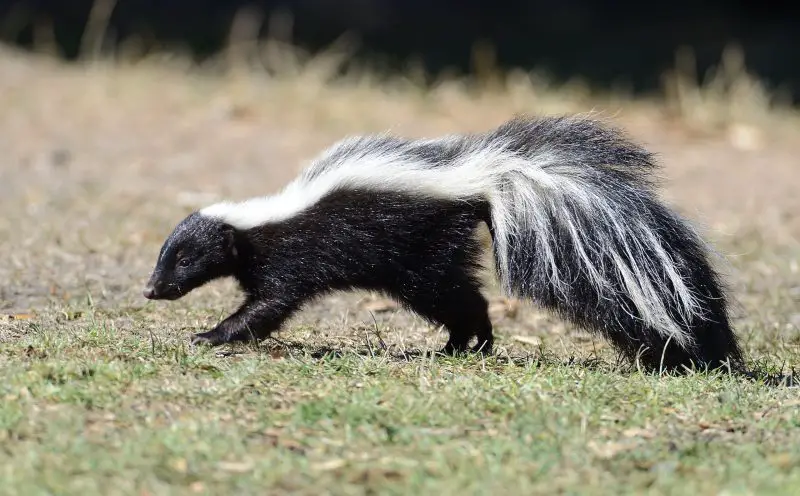
The Striped Skunk is the most widespread skunk species in North America and one of the most recognizable due to its bold black fur with two white stripes running from its head down the length of its back. These stripes often split and curve, making each individual’s pattern unique. Larger and bulkier than the Eastern Spotted Skunk, adults typically measure 22 to 30 inches long, including a bushy tail that adds visual drama when raised in defense. They weigh between 4 to 10 pounds, making them one of the largest members of the skunk family. Despite their infamous reputation for spraying, they are calm by nature and give several warnings—such as foot-stomping, hissing, and tail-raising—before resorting to using their powerful musk.
In Florida, the Striped Skunk is found throughout most of the state, although it becomes less common in the southernmost regions, such as the Everglades. These skunks are highly adaptable and thrive in open fields, forest edges, pastures, scrublands, and suburban neighborhoods, often denning under decks, porches, and brush piles. They are primarily nocturnal, and their nighttime wanderings can take them over several miles in search of food. Their diet is omnivorous and opportunistic—they consume insects, worms, fruits, small vertebrates, eggs, and even human refuse when available. Their strong claws and keen sense of smell help them dig up grubs and beetles from beneath the soil.
Striped Skunks breed in late winter, typically around February, with kits born in May or June after a gestation of about 60 to 75 days. Females usually give birth to 4 to 6 kits, which are raised in well-hidden dens until they are strong enough to accompany their mother on short excursions. Young skunks are capable of spraying by the time they are just a few weeks old. Family groups stay together through the summer, but as fall approaches, juveniles disperse to find their own territories. Skunks are non-aggressive and generally avoid confrontation, but their scent glands are so potent that few predators dare attack them.
A fascinating fact about Striped Skunks is their resilience in suburban environments—they’ve been known to live peacefully near humans, often going unnoticed until someone catches a whiff of their spray. Despite being known for their defense mechanism, they play a critical role in local ecosystems as natural pest controllers. Skunks in Florida help manage insect populations and even consume rodents, contributing to a healthier environment. They are also one of the few mammals that can safely eat stinging insects like wasps and bees, thanks to their thick fur and resistance to venom.
FAQs About Skunks in Florida
What types of skunks live in Florida?
Florida is home to two native skunk species: the Eastern Spotted Skunk (Spilogale putorius) and the Striped Skunk (Mephitis mephitis). The Eastern Spotted Skunk is smaller, with broken white stripes and spots, while the Striped Skunk is larger with two continuous white stripes along its back.
Where are skunks most commonly found in Florida?
Striped Skunks are found throughout most of the state, especially in open fields, suburban areas, and woodlands. Eastern Spotted Skunks are more secretive and mainly inhabit northern and central Florida, often in pine forests, brushy areas, and farmlands.
Are skunks in Florida dangerous to humans?
Skunks in Florida are not typically dangerous, but they can spray a powerful, foul-smelling musk when threatened. They are also potential carriers of rabies, though incidents are rare. It’s best to avoid contact and allow them space if encountered.
What do skunks in Florida eat?
Florida skunks are omnivores. Their diet includes insects, small mammals, fruits, eggs, amphibians, and carrion. They are also known to raid garbage or pet food if it’s left outside.
Do skunks hibernate in Florida?
No, skunks in Florida do not hibernate due to the state’s mild winters. However, they may become less active during colder periods and spend more time in their dens until temperatures rise.
When is skunk breeding season in Florida?
Striped Skunks breed around February, with babies born in May or June. Eastern Spotted Skunks tend to breed slightly earlier, in March or April. Both species give birth to litters of 2–6 kits.
Are Eastern Spotted Skunks endangered in Florida?
The Eastern Spotted Skunk is considered a species of concern in Florida due to declining populations. Habitat loss, pesticide use, and reduced food availability may contribute to their vulnerability.
How can I deter skunks from my property in Florida?
To prevent skunks from settling near your home, remove food sources like pet food and garbage, seal access points under porches or decks, and keep yards tidy. Motion-activated lights can also deter nocturnal visits.
Can skunks climb trees in Florida?
Yes, particularly the Eastern Spotted Skunk, which is an excellent climber. It often uses this skill to search for food or evade predators, unlike the more ground-bound Striped Skunk.
What should I do if I see a skunk during the day in Florida?
Skunks are usually nocturnal, so daytime activity could be a sign of distress, hunger, or disease. While not always dangerous, it’s best to observe from a distance and avoid interaction. Contact a local wildlife authority if the animal appears sick or unusually aggressive.


